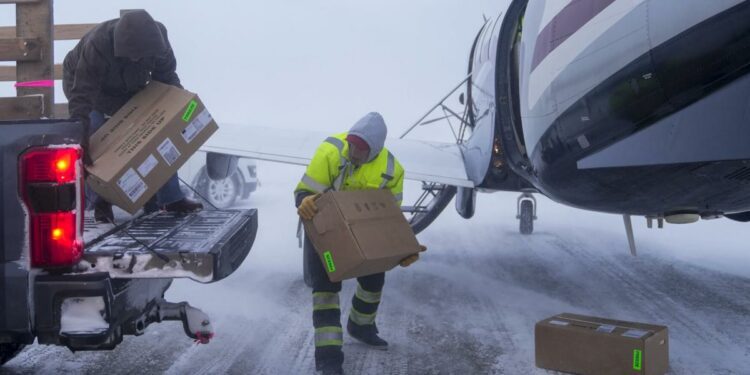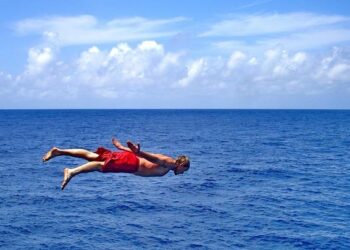A sign seeking election help is displayed Oct. 16 on the bulletin board in the community building in Kaktovik, Alaska.
Mark Thiessen, Associated Press
The right to vote is considered sacrosanct in the United States, but in the tiny, remote Native villages across Alaska — often accessible only by boats or small planes — challenges abound.
Mail and phone service can be unreliable, with severe storms or worker illness causing delays. Sometimes the polls simply don’t open if there’s no one trained to serve as an election worker, or if they don’t show up after being hired or quit before an election.
The result? Hundreds of people can be disenfranchised.
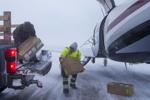
In blizzard winds, Lee Kayotuk, center, helps unload cargo Oct. 17 from the one flight of the day in and out of Kaktovik, Alaska.
Lindsey Wasson, Associated Press
That might shock voters or politicians elsewhere in the U.S., especially in swing states where polling irregularities prompt scrutiny from party activists and news organizations, conspiracy theories spreading on social media and calls for investigations.
Alaska’s problems garnered relatively little attention outside the 49th state.
The Associated Press sent journalists to Kaktovik — above the Arctic Circle on an island just off the northern coast of Alaska — to take a closer look at the hurdles facing Alaska Native voters.
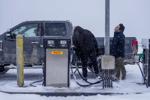
Edwin Solomon, 18, right, stands in the wind and snow Oct. 16 while filling up a truck with regular gas at a price of $7.50 a gallon in Kaktovik, Alaska.
Lindsey Wasson, Associated Press
A lack of poll workers
Recruitment and retention of poll workers is an ongoing problem for the Alaska Division of Elections, but it can be especially challenging in Native villages, where the cost of goods is high and populations are small.
Poll workers in Alaska can make $20 an hour, with precinct chairs, who oversee polling sites they’re assigned to, earning slightly more. Workers must commit to working a 16-hour day or to working a split shift, and they must attend a four- to five-hour paid training session.
Kaleak said the pay — $20.50 an hour — wasn’t enough to be attractive in a village where gas is $7.50 a gallon and other goods, shipped long distance, are pricey. Small pumpkins recently went for $80 apiece.
He also faulted the timing: The August primary arrives when many people are out hunting and fishing, on vacation or preparing for the upcoming whaling season.
Among the ways the state tried to boost interest is a “youth at the booth” program, which seeks to involve older teenagers in working elections.
In Kaktovik, recent high school graduate Edwin Solomon has been considering it. He didn’t vote in the primary and looks at voting in the general election as his “first step into adulthood.”
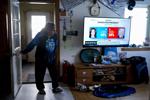
Alice Aishanna steps into her living room Oct. 15 while a CBS News broadcast shows Democratic presidential nominee Kamala Harris and Republican presidential nominee former President Donald Trump, at her home in Kaktovik, Alaska.
Lindsey Wasson, Associated Press
A recurring problem
Polls not opening is a recurring problem in rural Alaska.
During the August primary this year, precincts in Wales and Kaktovik failed to open. They opened late in several other villages. In Anaktuvuk Pass, the polling place didn’t open until about 30 minutes before closing time; just seven of 258 registered voters there cast ballots in person.
In the 2022 primary, Tununak and Atmautluak didn’t open when workers failed to show up. Two others — Holy Cross and Venetie — didn’t have enough poll workers, but voters were able to cast absentee ballots in person.
In that year’s general election, polls in the villages of Teller and Nuiqsut didn’t open until about 3:30 p.m.
Alaska allows absentee voting, but that can present its own challenges given the sometimes questionable reliability of mail delivery in rural Alaska.Â
In 2020, the state Division of Elections failed to send absentee ballots to the village of Mertarvik in time for the primary election because its staff didn’t realize anyone was living there.
The U.S. Justice Department, which enforces federal laws that protect the right to vote, declined to comment about polling places failing to open in rural Alaska. But for years, pursuant to a court order, it monitored elections in the state to ensure polling places provide language assistance to Alaska Native voters.
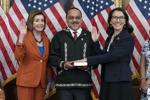
Then-Speaker of the House Nancy Pelosi, D-Calif., left, administers the House oath of office to Rep. Mary Peltola, D-Alaska, accompanied by her husband, Eugene “Buzzy” Peltola Jr., during a Sept. 13, 2022, swearing-in ceremony on Capitol Hill in Washington.
Jose Luis Magana, Associated Press
What’s at stake?
Alaska’s lone representative in the U.S. House is Democratic Rep. Mary Peltola — the first Alaska Native elected to Congress.
She faces Republican Nick Begich in a tight race that will help determine which party controls the House.
Peltola is popular among Alaska Native voters and was endorsed this month by the Alaska Federation of Natives, the largest statewide Native organization in Alaska. She suggested the race with Begich could be decided by “dozens of votes,” making the possible implications of any voter disenfranchisement significant.
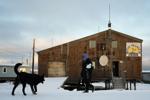
A neighborhood dog approaches a villager Oct. 15 walking past the Kaktovik Native Village office in Kaktovik, Alaska.
Lindsey Wasson, Associated Press
Is it being addressed?
State, regional and local officials all say they are trying to ensure everyone can vote in the Nov. 5 election.
Carol Beecher, director of the Alaska Division of Elections, called her agency “highly invested in ensuring that all precincts have workers and that sites open on time.” She acknowledged it can be difficult to find temporary workers to help run elections in remote villages.
Michelle Sparck, with the nonprofit Get Out The Native Vote, said her agency partnered with another organization and found 11 volunteers trained to work elections and are willing to fly to villages, if needed. One is already committed to Craig, a community of about 1,000 people — about 17% Native — on Prince of Wales Island.
The North Slope Borough — akin to a county government in other parts of the U.S. — said it also is prepared to send staffers to Kaktovik or other villages that might need help opening precincts if the state fails to hire anyone.
In remote Alaskan villages, challenges to voting abound
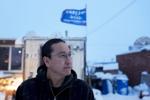
Charles Lampe, president of the Kaktovik Inupiat Corporation and a City Council member, poses for a portrait Oct. 16 outside his home in Kaktovik, Alaska.
Lindsey Wasson, Associated Press

Alice Aishanna steps into her living room Oct. 15 while a CBS News broadcast shows Democratic presidential nominee Kamala Harris and Republican presidential nominee former President Donald Trump, at her home in Kaktovik, Alaska.
Lindsey Wasson, Associated Press
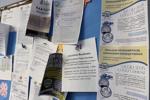
A sign seeking election help is displayed Oct. 16 on the bulletin board in the community building in Kaktovik, Alaska.
Mark Thiessen, Associated Press
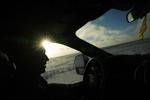
Kaktovik Mayor Nathan Gordon Jr. drives past open tundra Oct. 14 while keeping an eye out for polar bears on the west side of Barter Island near Kaktovik, Alaska.
Lindsey Wasson, Associated Press
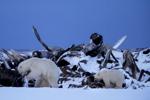
A polar bear and a cub search for scraps Oct. 15 in a large pile of bowhead whale bones left from the village’s subsistence hunting at the end of an unused airstrip near Kaktovik, Alaska.
Lindsey Wasson, Associated Press
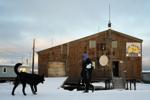
A neighborhood dog approaches a villager walking past the Kaktovik Native Village office Oct. 15 in Kaktovik, Alaska.
Lindsey Wasson, Associated Press
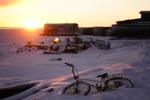
The sun rises over a bicycle covered in snow Oct. 15 at the edge of Kaktovik, Alaska.
Lindsey Wasson, Associated Press
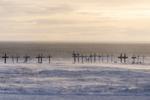
Wind blows snow along the surface of the village cemetery Oct. 14, looking toward the Kaktovik Lagoon and the coastal plain of the Arctic National Wildlife Refuge, in Kaktovik, Alaska.
Lindsey Wasson, Associated Press
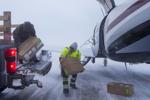
In blizzard winds, Lee Kayotuk, center, helps unload cargo Oct. 17 from the one flight of the day in and out of Kaktovik, Alaska.
Lindsey Wasson, Associated Press
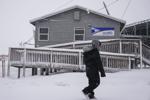
A resident walks with their child  Oct. 16 past the post office in Kaktovik, Alaska.
Lindsey Wasson, Associated Press
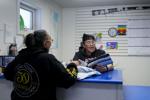
Postmaster Angel Akootchook, the village’s only full-time postal employee, hands a stack of mail to a resident Oct. 16 in Kaktovik, Alaska.
Lindsey Wasson, Associated Press
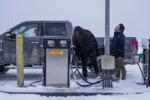
Edwin Solomon, 18, right, stands in the wind and snow Oct. 16 while filling up a truck with regular gas at a price of $7.50 a gallon in Kaktovik, Alaska. The state started a “youth at the booth” program that seeks to involve older teenagers in working elections and Solomon, a recent high school graduate, has been considering it. He didn’t vote in the 2024 primary and looks at voting in the general election as his “first step into adulthood.”
Lindsey Wasson, Associated Press

Chloe Gordon, 9, looks at her mother, Amanda Toorak, left, as they shop for packaged goods Oct. 15 at Sims Store, one of two small stores in Kaktovik, Alaska.
Lindsey Wasson, Associated Press
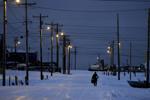
A villager walks through the snow Oct. 14 in Kaktovik, Alaska.
Lindsey Wasson, Associated Press
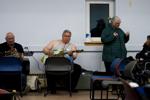
George Kaleak, center in gray, whaling captain and deputy advisor to the North Slope Borough mayor, plays guitar Oct. 14 during a “singspiration” community event to honor his late mother at the village community center in Kaktovik, Alaska.
Lindsey Wasson, Associated Press
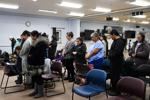
Community members bow their heads for a prayer Oct. 14 during the “singspiration” community event at the village community center in Kaktovik, Alaska.
Lindsey Wasson, Associated Press
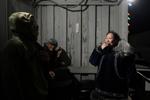
Kitty Ahvakana, right, takes a smoke break with other villagers Oct. 14 during a “singspiration” gathering, on the porch of the community center in Kaktovik, Alaska.
Lindsey Wasson, Associated Press
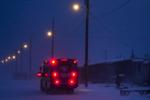
A child walks to the village’s school bus Oct. 17 during a blizzard in Kaktovik, Alaska.
Lindsey Wasson, Associated Press

An ermine runs through the snow with its catch Oct. 16 near a villager’s ATV as night falls in Kaktovik, Alaska.
Lindsey Wasson, Associated Press
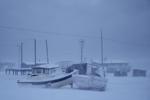
Small boats sit in a blizzard Oct. 17 in Kaktovik, Alaska.
Lindsey Wasson, Associated Press
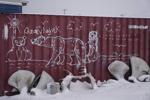
Polar bears and the Inupiaq word for “Kaktovik” are painted on a shipping container Oct. 16 in Kaktovik, Alaska.
Lindsey Wasson, Associated Press
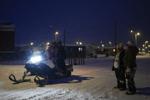
Children stop to talk with friends on a snowmobile Oct. 16 as they play in the snow after school in Kaktovik, Alaska.
Lindsey Wasson, Associated Press
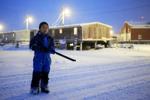
Johnny, 7, holds his pellet gun for warding away polar bears Oct. 16 as he goes out to play with other children after school in Kaktovik, Alaska.
Lindsey Wasson, Associated Press

An ermine runs through the snow with its catch near a villager’s ATV as night falls in Kaktovik, Alaska, Wednesday, Oct. 16, 2024. (AP Photo/Lindsey Wasson)
Lindsey Wasson
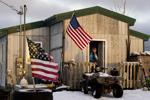
Alice Aishanna poses for a portrait Oct. 15 outside her home displaying several American flags in Kaktovik, Alaska.
Lindsey Wasson, Associated Press

The sun rises Oct. 15 over Kaktovik, Alaska, as a resident walks on a snowy road.
Lindsey Wasson, Associated Press
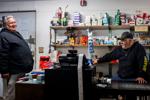
George Kaleak, left, whaling captain and deputy advisor to the North Slope Borough mayor, talks with cashier Kent Sims on Oct. 15 at Sims Store, one of two small grocery stores in Kaktovik, Alaska.
Lindsey Wasson, Associated Press

Prices of Halloween products are displayed Oct. 16 on a counter of the Kaktovik Kikiktak Store in Kaktovik, Alaska.
Lindsey Wasson, Associated Press
Source link : http://www.bing.com/news/apiclick.aspx?ref=FexRss&aid=&tid=6723cff2fe134510a3909f5c61606adb&url=https%3A%2F%2Frichmond.com%2Fnews%2Fnation-world%2Fgovernment-politics%2F2024-election-voter-disenfranchisement-indigenous-alaska%2Farticle_53d5d643-a6dd-5313-a138-afa68d8332ab.html&c=17335873611885217201&mkt=en-us
Author :
Publish date : 2024-10-31 01:30:00
Copyright for syndicated content belongs to the linked Source.

